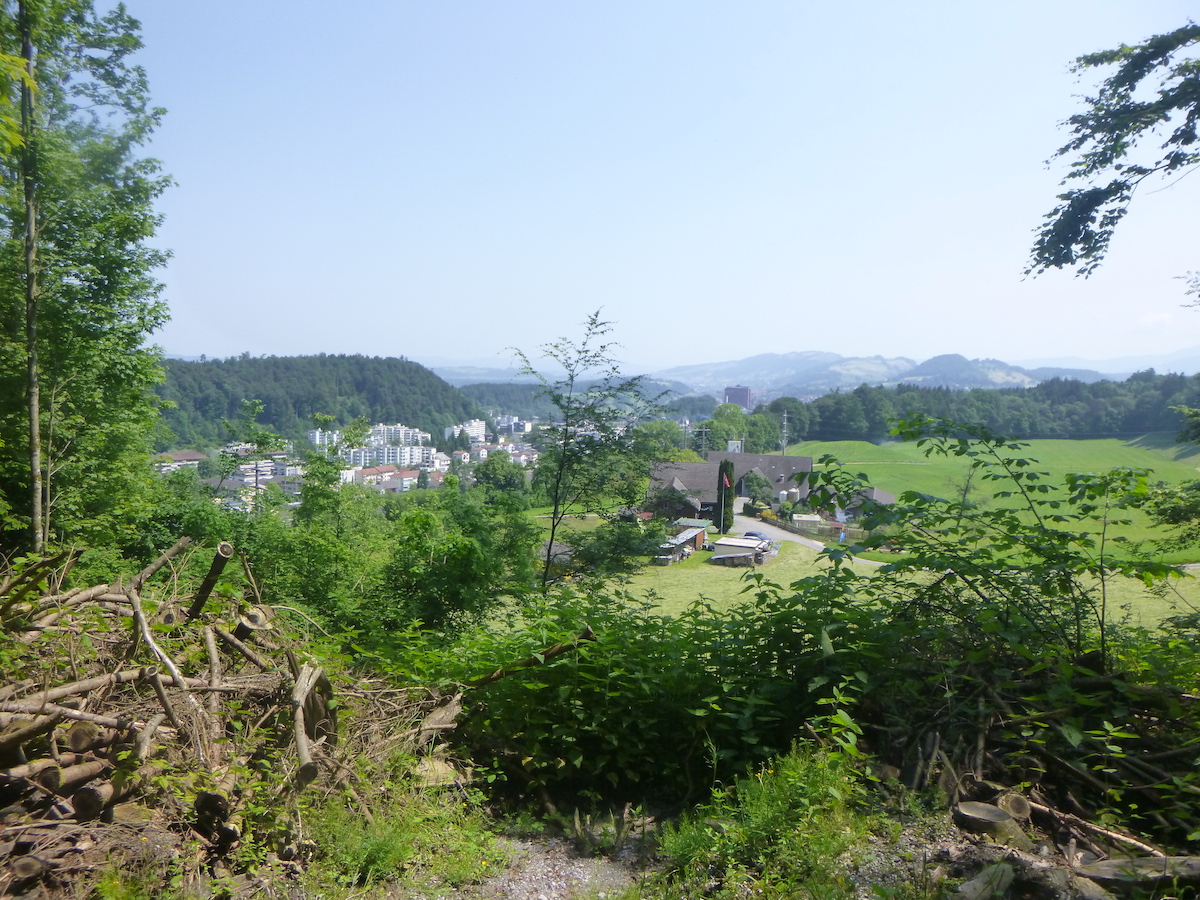An alternative route leaving Luzern via the Via Jacobi 4
DIDIER HEUMANN, ANDREAS PAPASAVVAS
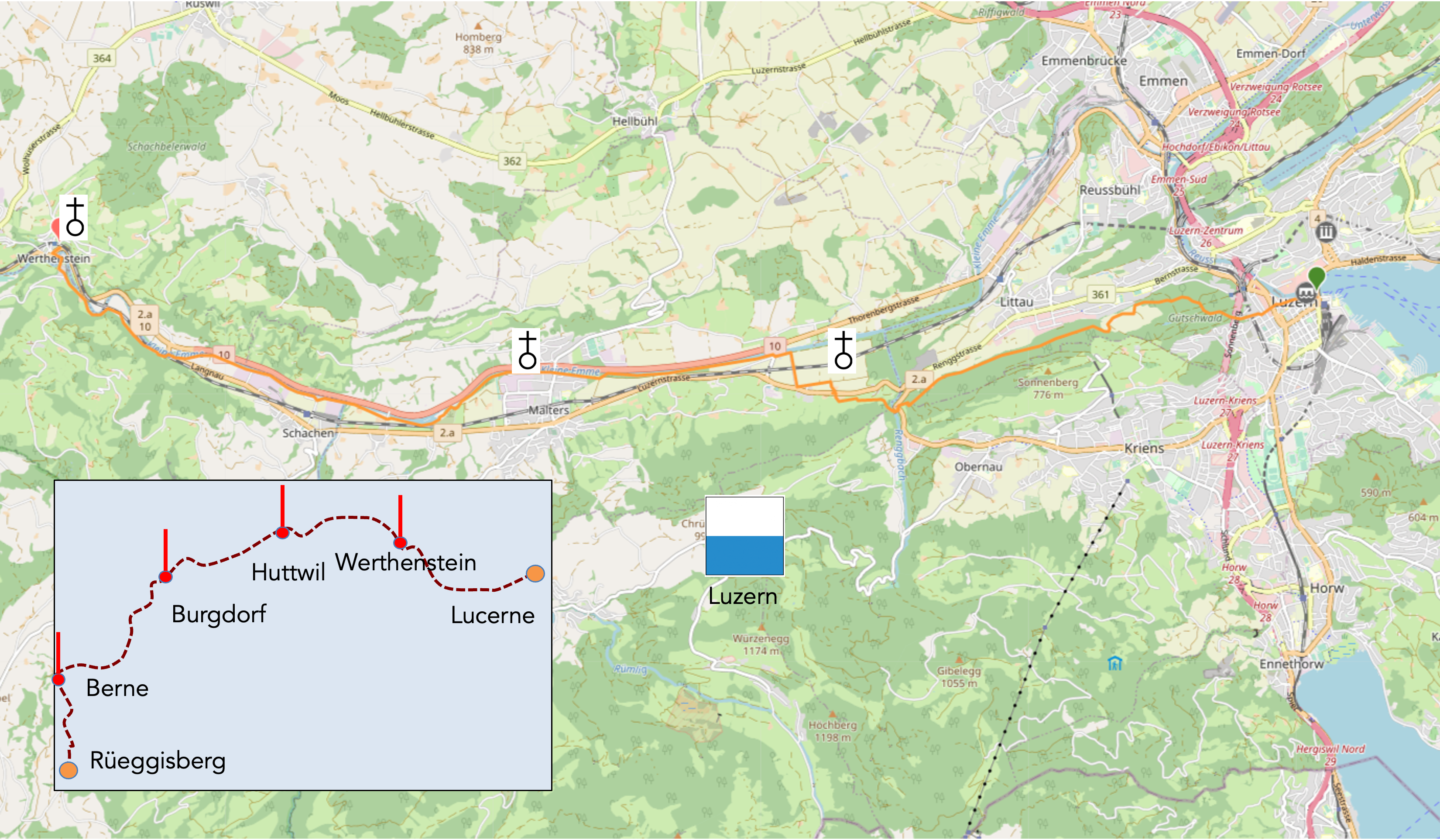
We divided the course into several sections to make it easier to see. For each section, the maps show the course, the slopes found on the course, and the state of the route (paved or dirt roads). The courses were drawn on the « Wikilocs » platform. Today, it is no longer necessary to walk around with detailed maps in your pocket or bag. If you have a mobile phone or tablet, you can easily follow routes live.
For this stage, here is the link:
https://fr.wikiloc.com/itineraires-randonnee/de-lucerne-a-werthenstein-par-la-via-jacobi-4-136425135
|
Not all pilgrims are necessarily comfortable using GPS or navigating routes on a mobile device, and there are still many areas without an internet connection. For this reason, you can find several books on Amazon dedicated to the major Via Jacobi 4 route, which runs through the heart of Switzerland and over the Brünig Pass. The first guide leads pilgrims through the German-speaking part of Switzerland up to Fribourg, while the second continues through French-speaking Switzerland to Geneva. We have also combined these two books into a compact, lighter, and highly practical version. While the descriptions have been slightly condensed, they remain detailed enough to guide you step by step along the way. Recognizing the importance of traveling light, this latest edition has been designed to provide only the essentials: clear and useful information, stage by stage, kilometer by kilometer. The stages have been carefully adjusted to ensure accessibility and alignment with available lodging options. These books go beyond simple practical advice. They guide you kilometer by kilometer, covering all the crucial aspects for seamless planning, ensuring that no unexpected surprises disrupt your journey. But these books are more than just practical guides. They offer a complete immersion into the enchanting atmosphere of the Camino. Prepare to experience the Camino de Santiago as a once-in-a-lifetime journey. Put on a good pair of walking shoes, and the path awaits you. |
|
|
|
 |
If you only want to consult lodging of the stage, go directly to the bottom of the page.
The Via Jacobi in Switzerland, an integral part of the extensive network of the Ways of St. James, is an iconic route that attracts pilgrims from around the world. The Via Jacobi 4, one of the main routes crossing Switzerland, is particularly popular among those coming from Germany, Austria, or Eastern European countries. Swiss pilgrims, on the other hand, often join the nearest route from their homes, making the Via Jacobi both a local and international route. In Luzern, a significant crossroads on the route, pilgrims have the choice between the Via Jacobi 3 and the Via Jacobi 4. Although each of the two routes offers a unique experience, the Via Jacobi 3 is often described as more charming, despite its slightly increased difficulty. However, the Via Jacobi 4 remains the preferred route for many walkers due to its ease and the landscapes it traverses, until the junction of the two tracks just before the Ränggloch gorges.
This choice between the Via Jacobi 3 and the Via Jacobi 4 symbolizes the many decisions pilgrims must make along the way, influenced by their personal preferences, physical condition, and spiritual or discovery quest. Guides and online resources are valuable tools for learning about the specific characteristics of each route. So, here we present the Via Jacobi 4, up to the junction of the two tracks just before the Ränggloch gorges. The choice is yours.
Sometimes, for reasons of logistics or housing possibilities, these stages mix routes operated on different days, having passed several times on these routes. From then on, the skies, the rain, or the seasons can vary. But, generally this is not the case, and in fact this does not change the description of the course.
It is very difficult to specify with certainty the incline of the slopes, whatever the system you use.
For those seeking « true elevations » and enthusiasts of genuine altimetric challenges, carefully review the information on mileage at the beginning of the guide.

Section 1: On the heights of Luzern and Littau

Overview of the route’s challenges: a route with challenging slopes.

|
The journey begins with a gentle fluidity, orchestrated by the train station square and the majestic Culture House, the KKL, proudly standing before the calm mirror of the lake. This scene is not merely a starting point but an open door to a multitude of possibilities, an invitation to adventure and discovery. |
|
 |
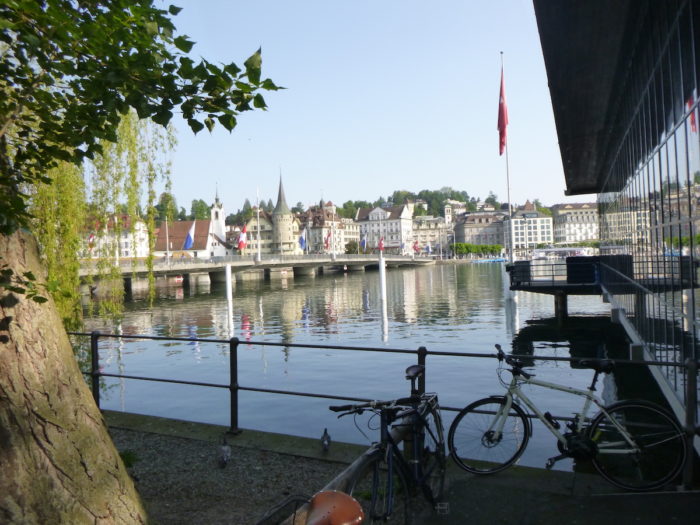 |
In this urban canvas where the bustle of departures mingles with the murmurs of promises, an imposing sign stands like a modern oracle, revealing the winding paths of hiking trails. Among them, the Via Jacobi 4 and Via Jacobi 3 trace their common route to the edge of the city. A significant detail lies in the blue rectangle enclosing the number of the Via Jacobi, always the faithful guide for pilgrims seeking Compostela. On this sign, preference seems to lean towards the Via Jacobi 4, but there’s no worry here, as both routes are common until the city’s outskirts.
|
Echoing the past, the route follows the banks of the Reuss, respectfully skirting the wooden bridge, the famous Kappelbrücke, an immutable testament to a craftsmanship of yore, perhaps already explored with wonder the day before. Each aged plank tells a story, each glimmer of light in the water whispers a city secret. |
|
 |
 |
| In this fluid ballet between time and space, route leads you onto Bahnhofstrasse, where the woven threads of daily life intersect. A bridge, a humble link of metal and wood, gracefully spans, connecting the two riverbanks like a bridge between two worlds. And there, nobly perched on the height, stands Gütsch Castle, a silent witness to the passage of centuries. | |
 |
 |
| The old stones of Bahnhofstrasse still resonate with the muted steps of past generations. Nearby stands the Jesuit College, an erudite guardian of ancient knowledge, erected as a bastion of wisdom in the heart of the city. Every stone, every window, seems to whisper an ode to wisdom and perseverance. |
|
 |
 |
Crossing the city is as easy as a leisurely stroll, where the winding streets are merely threads to follow. The route on this side is brief, but it requires vigilance, as several paths converge towards Malters, one of your next destinations. Follow the marked route towards Sonnenberg/Krienz, guided by the signs for routes 4 and 3.
| Bahnhofstrasse gradually reveals its urban treasures, leading to the vibrant heart of this part of the city. | |
 |
 |
| The road, like a modern Ariadne’s thread, then leads you near the Capuchin convent, nestled humbly in the peaceful embrace of Franciskanerplatz. Here, time seems suspended, as if the walls themselves whispered millennium-old prayers. | |
 |
 |
| Continuing your journey, you further venture into the picturesque Rütligasse, in a part significantly less frequented by tourists. | |
 |
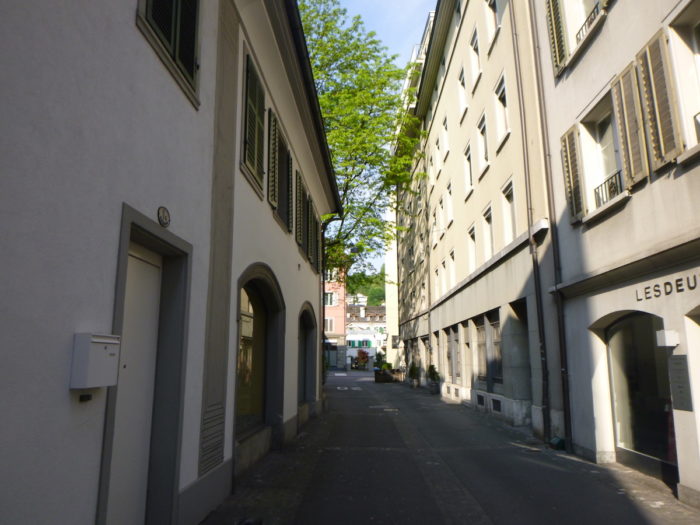 |
| Further along, your route leads you to Klosterstrasse, the first street to climb towards the heights that will free you from the confines of the city. | |
 |
 |
Midway up, the route splits in two, offering a choice that may seem trivial but holds paramount importance for the pilgrim seeking their own way. To the right lies Via Jacobi 4, proudly displaying the blue square of direction, an immutable symbol of the main Via Jacobi in Switzerland. To the left, Via Jacobi 3 continues its route. We’ll show you here the route on Via Jacobi 4.
| Via Jacobi 4 starts with vigor from its beginning, ardently climbing the slopes of Hochbühlstrasse, in the heart of the city. Here, the ascent is steep, flirting with 20% incline, a more challenging feat than that offered by Via Jacobi 3. It’s a trial, indeed, but the only one along this route, unlike its variant with more frequent obstacles. | |
 |
 |
 |
 |
| At the top of Hochbühlstrasse, where the gaze barely glimpses a manor hidden behind its screen of grilles, the route escapes the road to venture onto a path dotted with stairs. | |
 |
 |
Certainly, the ascent sets its pace, so steep that benches, like oases of respite, invite weary pilgrims to rest from their climb.
| Where the steps reach their peak, the slope takes a respite. Homes line the path, discreet sentinels of this hill crowned by the imposing Gütsch Castle, invisible from this side of the hill. | |
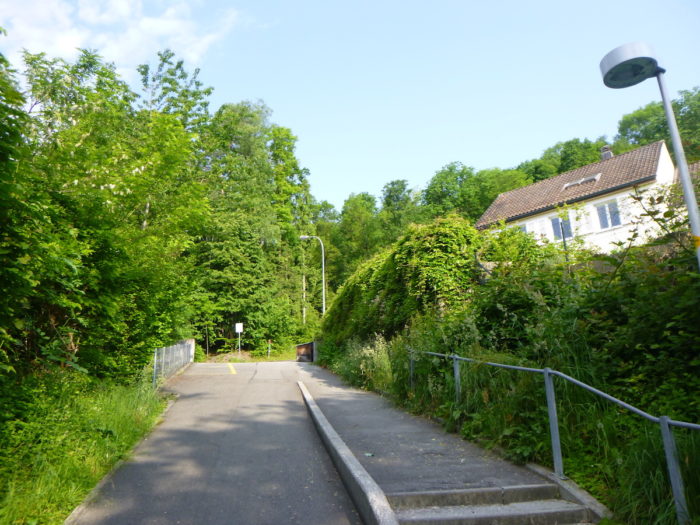 |
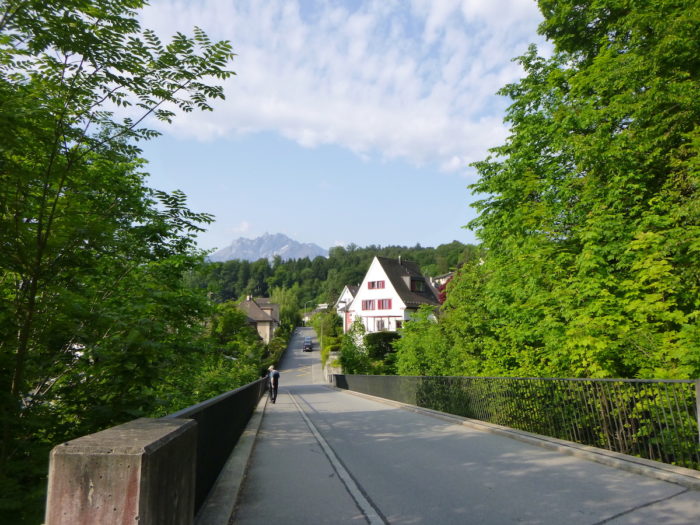 |
As you progress, a directional sign stands like a beacon, pointing the way to Oberwil, about thirty minutes’ walk away. It’s also the direction to follow to reach Sonnenberg on Via Jacobi 3. In this maze of possibilities, attention is required not to be distracted by the multiple paths tempting the traveler. A wrong turn? No matter, after all. The roads converge, although the elevation sharply distinguishes them.
| A little further, vigilance is required. To reach Sonnenberg, continue straight, while Via Jacobi 4 invites a right turn, where your adventure continues today. | |
 |
 |
| The path continues to climb, winding through the woods, to crest a discreet hill, like a first riddle posed by the forest before consenting to reveal its secrets more deeply. | |
 |
 |
| Further on, the path indulges in a sinuous dance, oscillating with pensive gentleness mostly on a gentle slope. It evolves on a forest carpet, sometimes welcoming, sometimes strewn with sharp-edged rocks, as if to remind travelers of the intrinsic duality of nature. | |
 |
 |
| The walk becomes a contemplation, a constantly renewed wonder in this vegetal sanctuary. Majestic oaks, slender spruces, maples, and beeches spread their branches in a solemn quest for light, drawing against the sky a tableau filled with vibrant energy. | |
 |
 |
 |
 |
|
Emerging from the embrace of a forest that is both protective and mysterious, the Via Jacobi 4 suddenly blossoms in the clearing of Oberwil, as if the path itself finally breathes after a long journey through the shadow of trees. |
|
 |
 |
|
The path transforms, becoming a dirt road that, like a ribbon, unfolds through the meadows towards a hamlet where the authentic heart of peasant life beats, vibrating to the rhythm of the seasons in the green pastures. |
|
 |
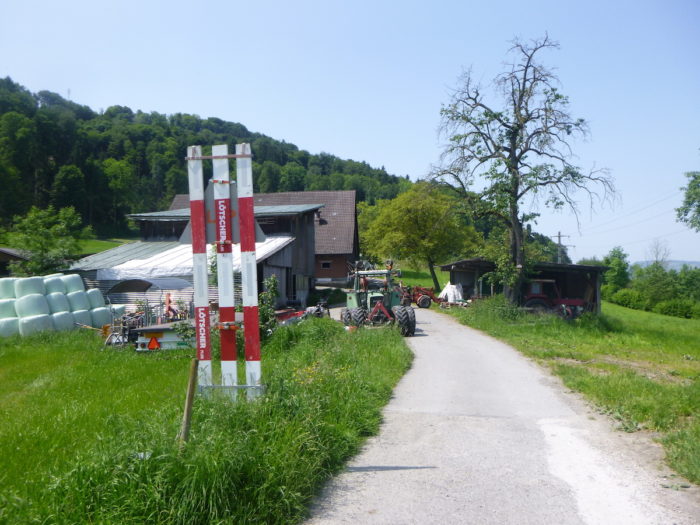 |
Poetic surprise on this path: an automatic box offering fresh milk. An unexpected vestige of modernity in these almost timeless places. Who then dares to come here to taste this rediscovered simplicity?
| A farm reigns there, not only vast but adorned with a thousand flowers, seeming to watch over Oberwil. From there, Ränggloch is only an hour’s walk away on Via Jacobi 4. | |
 |
 |
| The route, a beaten dirt road both wide and welcoming, climbs with restraint above the hamlet, heading once again towards the blaze of the woods. | |
 |
 |
Below, Littau unfolds its residential towers, bearing witness to the proximity of Luzern. This view offers a striking contrast, reminding that civilization is never far away, even in the most bucolic corners of our world.
Indeed, there is another way to reach Oberwil, bypassing Littau. To do this, simply escape from Luzern station, follow the winding course of the Reuss, and successively take Baselstrasse, Bernstrasse, and finally Luzernstrasse. At the edge of Littau, a discreet path reaches out to Oberwil. Although the altitude remains the same as on Via Jacobi 4, the climb is less arduous, as the sidewalk offers a more regular and easier slope to ascend.
| Continuing its journey through the forest, Via Jacobi 4 offers a gentle and continuous ascent, like a caress of nature, a steady breath propelling the steps of the walkers towards their destination. | |
 |
 |
Shortly after, a fork presents itself, offering travelers the opportunity to reach Sonnenberg via Via Jacobi 3. Yet, pilgrims resolve to continue their journey on Via Jacobi 4, faithful to their initial route.
| The path continues its ascent, still slightly, in a benevolent constancy, inviting walkers to rise ever higher, without haste or excessive fatigue. | |
 |
 |
Section 2: On the way to the Ränggloch Gorge

Overview of the route’s challenges : relatively easy route, till the junction to Via Jacobi 3.

|
In these wooded lands, spruces reign supreme, lifting their majestic silhouettes towards the sky, but beeches, maples, and oaks are not to be outdone, adding their touch of diversity and richness to this vegetal symphony. The atmosphere is airy, bathed in light filtering through the foliage, giving the forest a pleasant ambiance where each ray seems to caress the wooded ground. |
|
 |
 |
| Further on, the path descends into a prolonged descent, still on this broad path traced through the trees. The forest then transforms, adopting a more uniform, more exuberant appearance, adorned here and there with flamboyant bushes. Although perhaps less spectacular than on Via Jacobi 3 leading to Sonnenberg, this stretch of the route nevertheless offers the advantage of less physical demand. The effort required is almost non-existent, allowing walkers to daydream with their heads in the air. | |
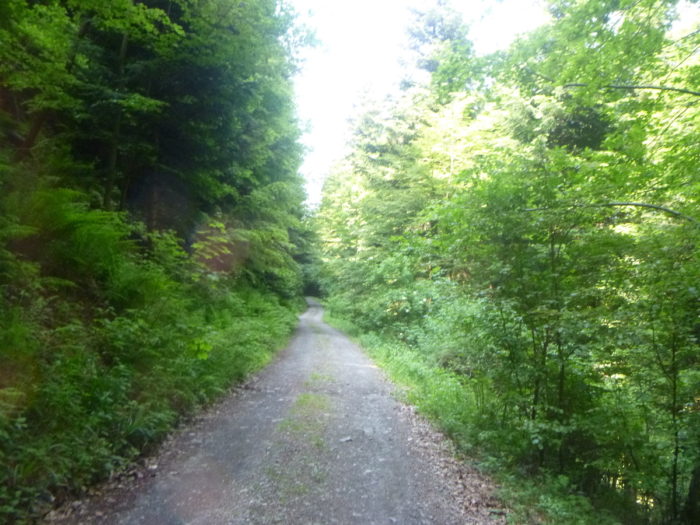 |
 |
| Shortly after this long descent, the path begins a new climb, this time on rougher ground, but still with the benevolence of a gentle slope that facilitates the progress of the walkers. |
|
 |
 |
| In this transition, the forest seems to undergo a subtle metamorphosis, offering more space between the trees, as if it were opening up to better reveal the vast expanse of the Littau plain unfolding below. | |
 |
 |
| The ascent continues a little further until it joins, on the heights, the route of Via Jacobi 3, where the two routes meet to become one, thus preparing the way for the descent towards Ränggloch. | |
 |
 |
From this precise point onwards, the road descends towards Ränggloch. Via Jacobi 3 and Via Jacobi 4 merge, sharing the same path until the entrance of Werthenstein.
To discover the rest of this journey, the route continues on the parallel stage (Stage 10a)… …
N’hésitez pas à ajouter des commentaires. C’est souvent ainsi que l’on monte dans la hiérarchie de Google, et que de plus nombreux pèlerins auront accès au site.
 |
Etape suivante : Etape 11: De Werthenstein à Huttwil |
 |
Retour au menu |
Feel free to add comments. This is often how you move up the Google hierarchy, and how more pilgrims will have access to the site.
 |
Next stage : Stage 11: From Werthenstein to Huttwil |
 |
Back to menu |








